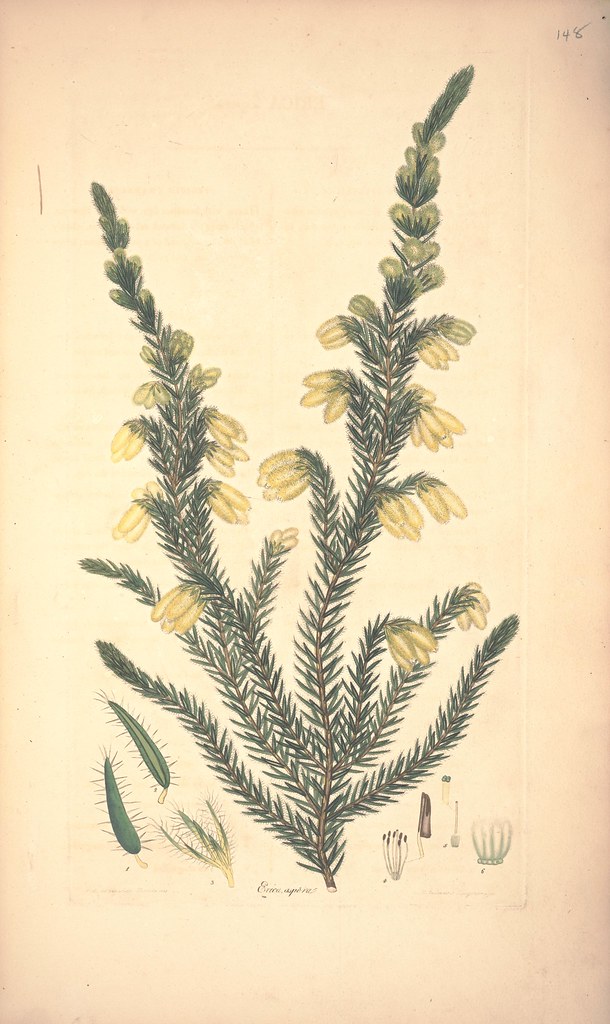Early 19th century hand-coloured
engravings of heath flowers
The vast majority of the 860+ species in the genus Erica (heaths/heather) are endemic to southern Africa. Plants from this genus don't respond well to being dug up and relocated and very few specimens were seen in Europe before the late 1700s. Discovery voyages eventually included botanists and specialist plant collectors and handlers. They could successfully preserve, dry or nurture Erica species and their parts, enabling samples to survive the rigours of a three month sea voyage to Europe.
An indication of the proliferation over time of African species of heather in Europe can be seen in this graph of ~publications on Erica species. The first large peak corresponds to the array of heath plants described in the book series from which the illustration plates below were selected.
By way of clarification: the Ericaceae family consists of two very similar genera: Erica (aka winter heather; and more likely called heath) and Calluna (aka summer heather, consisting of one species, Calluna vulgaris, from which the many popular heather varietals - domestic shrubs - have been bred). The species depicted below are from the Erica genus.
'Coloured Engravings of Heaths' by HC Andrews is a 4-volume series from the early 19th century (seen below), and is particularly noteworthy because the author is believed to have also taken on the roles of artist, engraver, publisher and hand-colourist. That level of multi-tasking is fairly rare in the world of scientific publishing, at least in my experience.
"This work exemplifies the 'Erica-mania' that dominated English horticulture at the beginning of the nineteenth century. Numerous newly discovered South African species were being introduced through the enterprise of nurserymen like Lee and Kennedy^, and several hundred species and varieties were available and in cultivation." [source]

Erica savileia

Erica racemifera

Erica primuloides

Erica pinifolia discolor

Erica mutabilis

Erica mucronata

Erica kibbertia

Erica hirta, var viridiflora

Erica erubescens

Erica emarginata

Erica elegans

Erica echiiflora

Erica densa

Erica decora

Erica clavata

Erica calycina major

Erica aurea, flore pallida

Erica aspera

Erica aristata
The full title of Henry Charles Andrews' publication is: 'Coloured Engravings of Heaths. The drawings taken from living plants only. With the appropriate specific character, full description, native place of growth, and time of flowering of each; in Latin and English. Each figure accompanied by accurate dissections of the several parts (magnified where necesary) upon which the specific distinction has been founded, according to the Linnæan system'. It appears Andrews was author-publisher of some six or eight botanical works in total (including a few multi-volume series); most on Erica/heath species, together with monographs on some rare plants and flowers. His name(s) make(s) tracking down his publishing record difficult to say the least.
"'Coloured Engravings of Heaths' published between 1794 and 1830 is regarded as the most significant work of the botanical artist Henry Charles Andrews {fl. 1784-1830) (Cleevely & Oliver 2002). He has always been something of an enigma. His dates of birth and death have not been discovered. His family background is obscure, apart from a link to the nurseryman John Kennedy (1759-1842) through his marriage to ^Kennedy's daughter, Anne (b. 1784). For much of his life Andrews lived in London, and judging by his numerous business addresses between 1813 and 1825, was rather unsettled. He described himself as ''Botanical printer and engraver" but from the evidence of a paper slip^ preserved in one copy of Coloured engravings he had another occupation, for this announced that 'H. Andrews respectfully informs the nobility. Gentry &c. that he continues to Teach DRAWING and COLOURING correctly from Nature, ETCHING, &c on the most reasonable terms.' " [source]
- 'Coloured Engravings of Heaths' (Vol 3) by Henry C Andrews has been made available online by Missouri Botanical Gardens through both the Biodiversity Heritage Library and their Botanicus website (though they both have different title pages for some reason; however, the illustrations appear to be identical in each).
- Henry Charles Andrews biography [W]
- pdf article direct: 'Cape heaths in European gardens: the early history of South African Erica species in cultivation, their deliberate hybridization and the orthographic bedlam' by Nelson & Oliver, 2004 IN: Bothalia 34 (2): 127-140
- A working list of all plant species from the genus Erica.
- How to Grow Heathers and Heaths.
- Antiquariaat Junk bookseller's page.
- Thanks J.O.
- The Humble Heather post first appeared on the BibliOdyssey website.

